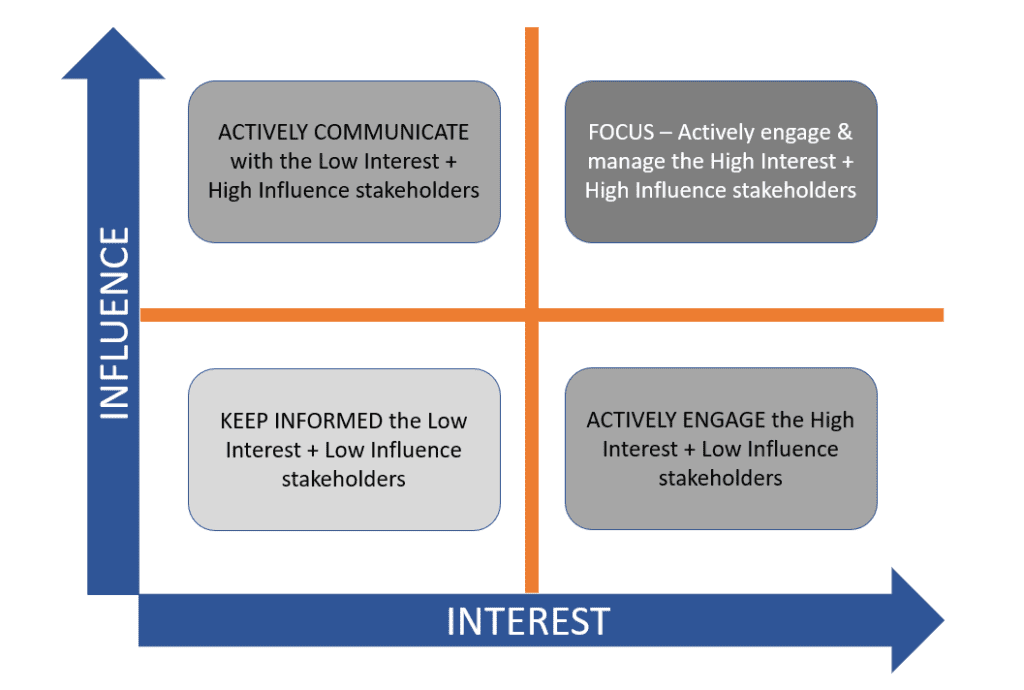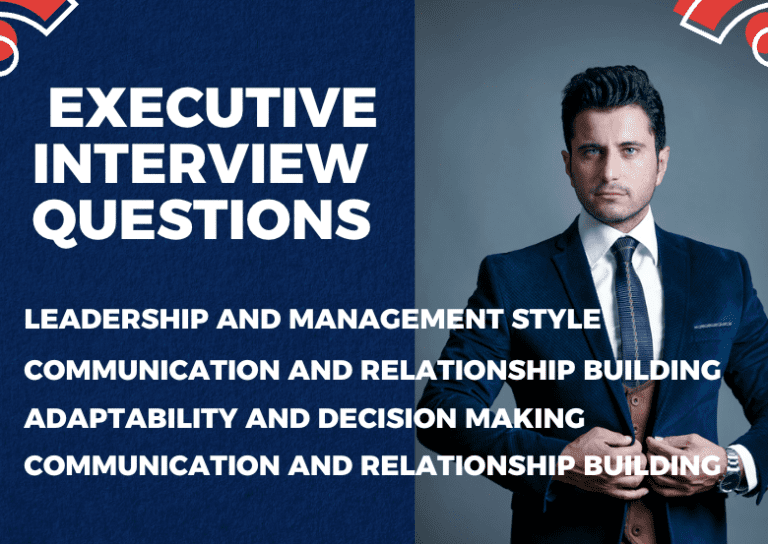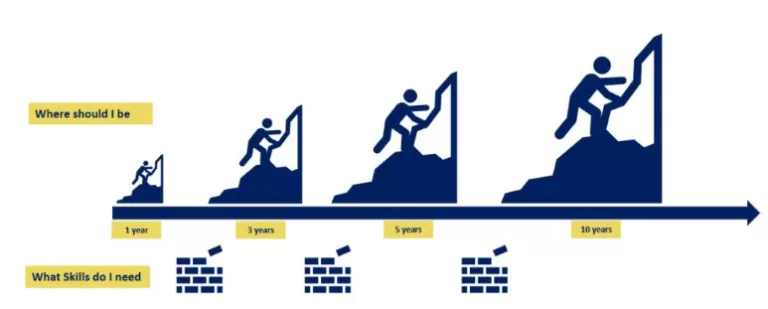How To Answer Stakeholder Management Interview questions: 15 Useful Examples
About the author: Ilam’s career in Technology and Financial Services spans more than two decades, characterized by leadership roles and vast international experience. He has managed large global teams, worked across five countries, and engaged with colleagues from over 100 nationalities. Through this blog covering executive interview questions, Ilam shares his diverse experiences and insights, aiming to contribute to and enrich the community.

Key takeaways from this post
- Significance of Stakeholder Management: Stakeholder management is a pivotal aspect of project execution, focusing on fostering positive relationships and effective communication.
- Essential Skills for Stakeholder Management: Successful stakeholder management requires strong communication, interpersonal skills, and conflict resolution capabilities.
- Typical Stakeholder Management Interview Questions: The blog provides a range of interview questions that assess an individual’s ability to manage stakeholders effectively.
- Guidance on Answering Interview Questions + Sample Answers: Suggestions are provided on how to respond to these questions, highlighting the importance of sharing real-life experiences from previous roles + sample answers.
- The Stakeholder Management Matrix: Stakeholder Management Matrix, a useful tool for identifying and managing stakeholders in a project.
Effective stakeholder management is an integral part of the project management process that necessitates exceptional communication, leadership, and conflict resolution abilities. As a project leader, managing multiple stakeholders while prioritizing deadlines and ensuring consistent communication is crucial to attaining project goals.
To prepare for your next interview, this blog highlights some critical interview questions and answers concerning managing stakeholders, communication skills, and leadership skills in the context of stakeholder management within the project management process.
Note: Please use this set of Stakeholder Management Interview Questions and answers for as an inspiration only. Hiring managers can smell a copy/paste answer from miles away.
Here are some helpful job interview related blogs
- Tackling the final interview round
- How to answer ‘tell me about yourself’
- What are your career aspirations
- Why do you want this job
- Why should we hire you
- Why are you leaving your job
- What are you passionate about
- Strengths and Weaknesses In Interview
- Interview questions for managers
- What is your management style
- Interview questions for freshers
- Tips to succeed in a job interview
- Types of interview questions
- Interview questions to ask candidates
- Behavioural interview questions
- Walk me through your resume
- What makes you unique
- What are your goals
- How do you handle stress and pressure
- Are you a team player
- How did you hear about this position
- Where do you see yourself in five years
- How do you handle stakeholders
Why Do Hiring Managers Ask Stakeholder Management Interview Questions?
Asking stakeholder management interview questions is a common practice among hiring managers during the recruitment process. The reason for this is that effective stakeholder management is crucial to the success of any project or organization, making it a highly valued skill in today’s business environment.
Hiring managers ask these questions to assess the candidate’s ability to identify and manage stakeholders, maintain positive relationships, and communicate effectively. They want to determine how the candidate handles conflicts, manages deadlines, and prioritizes stakeholder needs. Additionally, they may use these questions to understand how the candidate’s past experiences relate to the specific requirements of the job.
Hiring managers also use stakeholder management interview questions to assess a candidate’s leadership skills. They want to determine if the candidate can lead a team while ensuring that all stakeholders are satisfied. They may also ask questions that assess the candidate’s ability to negotiate and persuade stakeholders.
Ultimately, the goal of hiring managers is to determine if a candidate has the skills and experience necessary to effectively manage stakeholders and achieve project success. By asking stakeholder management interview questions, hiring managers can gain insight into a candidate’s abilities, allowing them to make informed hiring decisions.
What is stakeholder management, and why is it important?
Stakeholder management is a proactive approach to understanding and engaging individuals who constitute the foundation of any project. By actively seeking out feedback, ideas, and concerns of external stakeholders such as customers, clients, vendors, and communities and internal stakeholders such as employees, managers, and shareholders through stakeholder management processes, risks can be assessed more accurately before the project begins.
This in turn helps eliminate delays and conflicts throughout project implementation stages due to unmet expectations – thus leading to greater overall project efficiency and quality. Thus it’s easy to see why effective stakeholder management plays an essential role in successful projects of all sizes.
Who are the key stakeholders in a project?

Key stakeholders in a project can include project sponsors, resource managers, key team member, a managing director, and external stakeholders such as customers, suppliers, and regulators. It’s important to identify all stakeholders involved in the project and understand their roles and responsibilities to ensure their needs are met throughout the project’s lifecycle.
Despite their dissimilar roles and power, each stakeholder holds the potential to both influence and be affected by the success of this project.
What are some essential stakeholder management skills?
Essential stakeholder management skills include the ability to effectively communicate, build and maintain relationships, actively listen, identify potential risks and issues early on, and deal with conflicts diplomatically. Additionally, stakeholders should be kept informed of developments throughout the project lifecycle and engaged regularly to ensure their feedback is appropriately incorporated into the project.
Finally, effective stakeholder management requires a strong problem-solving and decision-making approach as well as an understanding of the goals and objectives of each stakeholder.
Or you can use a bullet point structure.
Strong Communication Skills
Project managers must be able to communicate clearly and regularly with stakeholders to ensure everyone is on the same page. Strong communication skills are essential for maintaining positive relationships with stakeholders and resolving conflicts in a timely and professional manner.
Interpersonal Skills
To build and maintain positive relationships with stakeholders, project managers must have strong interpersonal skills. These skills are also essential for conflict resolution and effective communication.
Conflict Resolution
Project managers must be able to resolve conflicts in a timely and professional manner. Strong conflict-resolution skills are essential for maintaining positive relationships with stakeholders and effectively managing projects.
How do you manage multiple stakeholders with conflicting priorities?
Managing multiple stakeholders with conflicting priorities can be challenging, but it’s essential for project success. The key is to prioritize deadlines and communicate clearly with all stakeholders to ensure everyone’s needs are met. This may involve negotiating priorities and finding compromises that satisfy all stakeholders. It’s also important to remain flexible and open to feedback and changes in the project’s scope.
What is your experience with stakeholder involvement?
When answering this question, provide examples of your past roles where you worked with different stakeholder groups. Highlight your ability to manage stakeholders’ expectations, build relationships, and provide clear expectations for stakeholder involvement. Also, describe your approach to working with internal and external stakeholders to ensure their needs are met, and provide real-life examples of how you handled stakeholder involvement in a previous project.
Can you provide an example of a successful project you managed, and how you ensured stakeholder buy-in?
When answering this question, describe a certain project you managed in the past and how you ensured stakeholder buy-in. Highlight how you communicated the project’s goals, progress, and milestones to stakeholders and provided regular updates on the project’s status. You can also discuss how you worked collaboratively with stakeholders to address any issues or concerns that arose during the project’s lifecycle, and how you delivered positive results for the project’s overall success.
How do you handle stakeholder conflict?
When answering this question, highlight your conflict resolution skills and provide an example of a real-life scenario where you handled stakeholder conflict effectively. Describe how you listened to stakeholders’ concerns, identified the root cause of the conflict, and worked collaboratively to find a solution that satisfied all stakeholders. Highlight your ability to remain calm and professional, even in stressful situations, and your ability to retain information to ensure that conflicts are not repeated.
Can you provide an example of a time when you had to prioritize deadlines for multiple stakeholders?
When answering this question, provide an example of a time when you had to manage the expectations of multiple stakeholders with conflicting priorities. Explain how you communicated clearly with stakeholders and negotiated deadlines to meet all their needs. Highlight your ability to prioritize tasks efficiently, prioritize deadlines successfully, and remain organized and focused in difficult situations. Additionally, describe how you kept stakeholders updated on the project’s progress, and managed any changes or issues that arose during the project.
What strategies do you use to ensure successful stakeholder engagement with the project team?
When answering this question, discuss your approach to working with stakeholders to ensure their needs are met throughout the project. Describe how you maintain effective communication (as a project manager) with stakeholders, provide updates on the project’s progress and milestones, and involve stakeholders in decision-making processes. Additionally, highlight your ability to build positive relationships with stakeholders by listening to their concerns and working collaboratively to find solutions. Finally, explain how you use feedback from stakeholders to improve the project’s overall success.
Can you provide an example of how you managed multiple stakeholders with conflicting priorities and interests? / How to deal with tough stakeholders / difficult stakeholders ?
Answer: Sure, in my previous position, I was working on a project that involved several challenging stakeholders with competing priorities. I scheduled a meeting with all the project stakeholders to understand their expectations and priorities for the project. I then worked to create a plan that incorporated all their priorities and requirements, while also ensuring that we met the project’s overall goals and deadlines.
Throughout the project, I maintained consistent communication with all the difficult stakeholders and provided regular updates on progress. When conflicts arose, I worked with the difficult stakeholder stakeholder to identify the root cause and find a resolution that met everyone’s needs as best as possible. By keeping all stakeholders informed and involved in the project, we were able to complete it and deliver results that met everyone’s expectations. This is of course not the only way, but this was how I could manage difficult stakeholders.
How do you prioritize deadlines when managing multiple stakeholders?
Answer: When managing multiple stakeholders, it’s important to prioritize deadlines based on the overall project goals and the stakeholders’ priorities. I always start by creating a project plan with clear deadlines and milestones, then work with stakeholders to ensure their priorities are accounted for within that plan.
If there are conflicts between stakeholder priorities and deadlines, I work to find a compromise that meets everyone’s needs as best as possible. For example, if one stakeholder needs a certain deliverable by a certain date, but another stakeholder needs more time to provide input, I might adjust the project plan to allow for input from the second stakeholder while still meeting the first stakeholder’s deadline.
Ultimately, my goal is to ensure that we meet all project deadlines while still satisfying the needs of all stakeholders involved.
How do you build relationships with stakeholders, particularly those with whom you may not have a preexisting relationship?
Answer: Building relationships with stakeholders is an essential part of stakeholder management, particularly when working with external stakeholders or stakeholders with whom you may not have a preexisting relationship. To build these relationships, I start by making an effort to understand the stakeholder’s goals, needs, and priorities for the project.
I then work to establish regular communication with the stakeholder, whether through phone calls, emails, or in-person meetings. During these communications, I make an effort to actively listen to the stakeholder’s concerns and address any issues or questions they may have.
I also strive to build trust and rapport with stakeholders by being honest and transparent about the project’s progress and any challenges we may be facing. By demonstrating a commitment to open and honest communication, I’m able to build strong relationships with stakeholders that facilitate effective collaboration throughout the project.
How do you manage stakeholder buy-in?
Answer: Managing stakeholder buy-in is an essential part of stakeholder management, particularly when working with key stakeholders who may have a significant impact on the success of the project. To manage stakeholder buy-in, I start by engaging stakeholders early on in the project to ensure they feel involved and invested in the project’s success.
Throughout the project, I maintain consistent communication with stakeholders and provide regular updates on progress. I also work to address any concerns or questions stakeholders may have, and actively seek their input and feedback on project decisions.
If stakeholders are resistant to certain aspects of the project, I work to understand their concerns and find ways to address them while still meeting the project’s overall goals and objectives. By maintaining open and transparent communication, and actively engaging stakeholders throughout the project, I’m able to manage stakeholder buy-in and ensure the project’s success.
Can you describe a time when you had to resolve a conflict between two stakeholders?
Answer: Sure, in a previous project, I had two stakeholders with conflicting priorities and goals. One stakeholder wanted to prioritize the project’s speed and efficiency, while the other wanted to prioritize its accuracy and completeness.
To resolve this conflict, I worked with both stakeholders to understand their goals and create a project plan that incorporated both of their needs while still allowing us to meet the project’s overall deadline.
To keep the stakeholders engaged and on board throughout the project, I maintained regular communication and provided consistent updates on progress. I also sought input from each stakeholder at key points in the project and developed a system for resolving any conflicts that arose.
By taking an active role in managing this conflict and fostering collaboration between the stakeholders, I was able to successfully resolve the issue while still meeting all of the project’s goals.
How do you handle conflicts between stakeholders with competing interests?

Answer: When dealing with conflicts between stakeholders with competing interests, I would first listen to all parties involved and try to understand their perspectives. I would then identify the common ground and explore alternative solutions that address the needs of all stakeholders. If necessary, I would seek the advice of the project sponsor or senior management to help resolve the conflict. Communication is key in managing conflicts, so I would ensure that all stakeholders are aware of the situation, the steps being taken to resolve it, and the expected outcomes. In the end, my goal is to find a solution that is mutually beneficial and helps move the project forward.
Can you describe a situation where you had to manage a stakeholder’s ideas that were not aligned with the project goals?
Answer: In a certain project I worked on, one of the stakeholders had an idea that they believed would significantly improve the project’s outcomes. However, this idea was not aligned with the project goals and could have resulted in delays and additional costs. To manage this situation, I first listened to the stakeholder’s ideas and understood their perspective. I then explained how the idea did not align with the project goals and could impact the project’s timeline and budget.
I suggested alternative solutions that addressed the stakeholder’s concerns while still aligning with the project goals. I also emphasized the importance of staying focused on the project’s objectives and ensuring that all stakeholders are working towards the same goal. In the end, the stakeholder was receptive to the alternative solutions and agreed to support the project’s goals.
Bonus: Stakeholder Management Matrix

The Stakeholder matrix is a tool that can be used to identify and manage stakeholders in a project. It helps project managers identify the stakeholders who are most critical to the success of the project and develop strategies to manage their involvement. The Stakeholder Circle includes four quadrants:
High Power/High Interest: This quadrant identifies the stakeholders who have the most power and interest in the project. These stakeholders require the most attention and should be managed closely.
High Power/Low Interest: This quadrant identifies the stakeholders who have a lot of power but low interest in the project. These stakeholders should be kept informed, but not necessarily involved in every decision.
Low Power/High Interest: This quadrant identifies the stakeholders who have a high level of interest in the project, but not a lot of power. These stakeholders should be engaged and kept informed about the project’s progress.
Low Power/Low Interest: This quadrant identifies the stakeholders who have low power and low interest in the project. These stakeholders should be monitored, but not given a lot of attention.
Conclusion
Stakeholder management is an important aspect of any project, and it requires a range of skills and competencies. To succeed in stakeholder management, project managers must have strong communication and interpersonal skills, be able to manage multiple stakeholders and be able to resolve conflicts and build relationships.
During job interviews for project management roles, hiring managers may ask a range of stakeholder management interview questions to assess a candidate’s ability to manage stakeholders effectively. By providing clear and concise answers, and providing real-life examples of stakeholder management, candidates can demonstrate their skills and competencies and increase their chances of securing a role in project management.
Article also published on author’s Medium.com profile
More from the author on Agile coach, Scrum Master / Product Owner / Why you need a Career Coach / Interview Coach / Managing Managers / IT Career switch. He’s also is a keen AI enthusiast & writes about popular AI tools like Jasper, Writecream etc.
Disclosure: This site is user supported. Some of the links in this article may be affiliate links, which can help me buy a coffee or two if you decide to purchase a paid plan. These are products I’ve personally used and stand behind.





